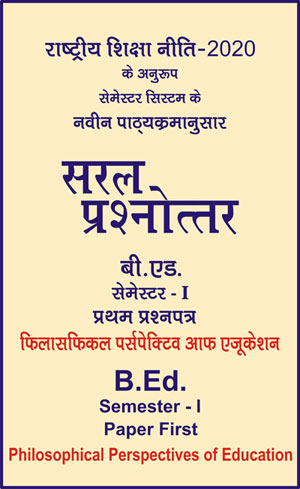|
बी एड - एम एड >> बी.एड. सेमेस्टर-1 प्रश्नपत्र-I - फिलासफिकल पर्सपेक्टिव आफ एजुकेशन बी.एड. सेमेस्टर-1 प्रश्नपत्र-I - फिलासफिकल पर्सपेक्टिव आफ एजुकेशनसरल प्रश्नोत्तर समूह
|
5 पाठक हैं |
|||||||
बी.एड. सेमेस्टर-1 प्रश्नपत्र-I - फिलासफिकल पर्सपेक्टिव आफ एजुकेशन (अंग्रेजी भाषा में)
Unit - III
Chapter 4 - Indian Philosophy and It’s Contribution
Question- Explain the concept of aims of education, curriculum, leading methods and discipline according to Vedanta Philosophy.
Answer -
Vedanta in Education
Education during Vedic period was the 3rd eye, eye of insight and source of illumination. This education system was originated from the Vedas and thus was called as Vedanta or Vedic system of education. This emphasized on code of conduct for both, teacher and student as well and also entrusted the student under the core and guidance of the teacher.
Aims of Education: These are mentioned below:
-
Citta-Vritti-Nirodh: Education must aim self-fulfillment and provide freedom from worldly affairs and attachment.
-
Education of Mind: Education must instill creativity and provide wisdom to understand culture and civilization.
-
Make Living Worthy: One of the aim of education is to make life meaningful, purposeful, and worthy.
-
Tasmo-ma-Jyotirgamaya: Another aim of education is to dispel darkness, dogmas, or doubts.
-
Religion Centered: Religion dominates every aspect of human life at various levels. Hence, education should be in conjunction with religion.
-
Individual Centered: Education should aim at overall development of an individual.
-
Nature Oriented: Education must bring man closer to nature, so educational institutions were located in peaceful surroundings of nature.
Curriculum: Curriculum of Vedanta is categorized into two divisions as per Kathoupanishads:
(a) Para-Vidya (Spiritual learning)
(b) Apara-Vidya (Worldly learning)
(a) Para-Vidya (Spiritual learning): This includes the study of 4 Vedas. Along with Vedas, Vedaryas, Upanishads, Puranas, Pitr-ye (rules for sacrifices for ancestors), Vakovakya (logic), Ekayema (ethics), Devavidya (etymology), Brahmavidya etc. were taught under this category.
(b) Apara-Vidya (Worldly Learning) : This includes subjects related to worldly affairs such as history, Ayurveda, Economics, Astrology, Physics, Zoology, Chemistry, Science, Kalpavidya, the rashi (science of numbers), Bhutvidya (science of demons) etc. were taught under this category.
Methods of Teaching: Two methods of teaching were practiced under Vedic age. The first method was called Mukhik (oral) and the second was based on chintan (thinking or reflection). Mukhik or oral method enables students to memorize the mantras (Vedic hymns) and richayas (verses of Rigveda).
The process of education passed through three stages namely:
(i) Shravan (Hearing)
(ii) Manan (Meditation)
(iii) Nidhi dhyasan (Realization and Experience)
Also, methods of teaching enabled apprenticeship programs. Various strategies like simple to complex, activity and skill-oriented programs were used while imparting education. Some techniques like question-Answer - technique and illustration, self-study were considered important methods of teaching.
Discipline: These include:
- Code of conduct for students and teachers as well were mentioned.
- Dress code was observed.
- Observation of Brahmacharya or celibacy was compulsory for all students.
|
|||||














